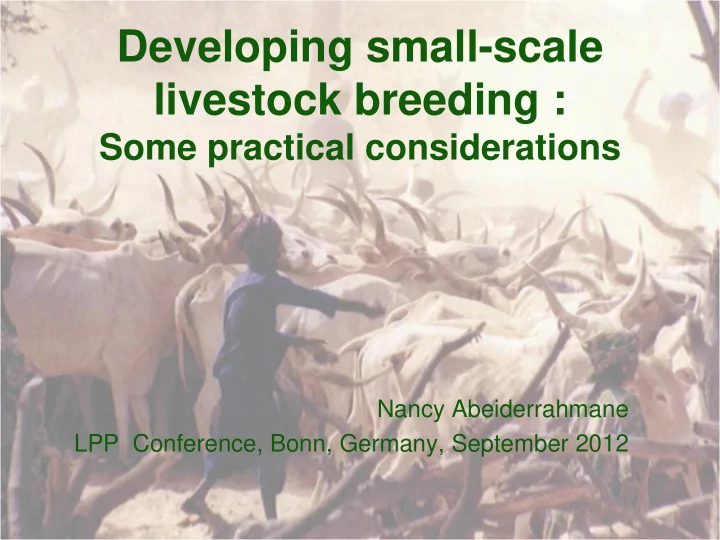

Developing small-scale livestock breeding : Some practical considerations Nancy Abeiderrahmane LPP Conference, Bonn, Germany, September 2012
Undisputed facts : Growing world population. Over half of it urban. Rising global and per-capita meat & dairy consumption. Arid lands spreading worldwide.
Less acknowledged fact: Small-scale livestock keeping is economically reasonable for: Remote locations, Sparse pasture, arid zones, Indigenous breeds.
Valuable comparative & competitive advantages: Properly done, small-scale husbandry yields: More rural employment & income, Lower inputs and cost, Environment and biodiversity protection, Co-operation with farmers (fodder) instead of conflict, Food production on marginal land. Improved arid land productivity – livestock scatters seeds.
Furthermore Growing urban demand for natural, high-quality (not industrial) meat and dairy. Globally, arid lands can produce wholesome food for the world.
So where is the problem? Main hurdle: getting produce to market. Particularly difficult for pastoralists. Animal products require processing for sanitary and shelf-life reasons.
Where is the solution? Proposed: Farmers’ markets and direct sales: cannot always reach distant urban markets. Are lo-tech solutions an answer? Are “cottage industries” suitable? In my opinion: NO.
Other options Corporations buy raw materials at low prices to capture maximum added value: Not enough. Fair Trade is better than Unfair Trade: Still not enough.
Value chain, e.g. for milk, no processing unit Stakeholders Little milk sold (= producer revenue)
With processing unit Stakeholders More milk = More suppliers and income Transporter Farmer Dairy Plant Grocery Livestock shop owner Consumer Mill Wholesale Workforce trader
The value chain A vital link in the breeder-to-consumer value chain: the unit (e.g. industry) that processes raw meat, milk, hide, wool, etc. locally into market- ready merchandise. ‘PULL’ for farmers, ‘PUSH’ products towards bigger, remote markets. Optimum outlet for small producers, Added-value (major development factor) including local jobs.
Milk collection centre
Where are the vital links? This type of enterprise gets medals and awards but often cannot get LOANS / CREDIT
The vital link Most small herders cannot run an industry. Not easy, requires managerial skills and technical knowledge. Can NGOs or farmer co- ops do it well…? Entrepreneurs (a particular variety of humans) seem to do it better.
A sustainable solution Funding must be made available to small/medium sized processing units that undertake to: Buy raw materials from small producers, Make high-quality products, including niche products, unique breeds, organic, AOC, etc. Pay fair prices and/or re-invest some profit in communities.
A sustainable solution L ocal banks can pool resources in a dedicated Fund to reduce individual outlay and risk. Loans only to entrepreneurs signed up to this outlook. Some independent input required to select projects. The Fund also invests to ensure coaching, compliance and repayment.
Additional Benefits Livestock owners use a reliable income to: improve health & living standards, children’s education, etc. improve animal feeding, health, welfare, boost productivity. Reducing the need for Government inputs, NGOs or Aid.
A real-life business example Tiviski started a mini-dairy plant in 1989. Initial investment $300,000, including a $200,000 loan from French AFD. First milk collection and pasteurisation in West Africa, and many subsequent Firsts: “crazy”
A real-life business example All raw milk bought from pastoral herders, at high price: average $0.60. Successful strategies: modular collecting / chilling centres, chilled transport, state-of-the art processing, direct delivery to retailers.
The dairy plant has grown: Overall investment roughly $6 M. Up to 200 staff, Up to 1,000 milk suppliers, Five competitors...
The UHT plant (cow milk only, so far !)
A modern dairy product range All made from fresh camel, cow or goat milk, processed to international standards. QUALITY FIRST!
A modern dairy product range Including unique camel cheese.
Impact Thanks to the dairy industry: 1,000 to 2,000 herders no longer poor, At least 7,500 tonnes of milk processed annually, Overall sales approx. $10 M Could be more if milk importers did not actively hinder UHT sales.
Annual revenue for herders : at least $5 M
Can it work? YES! If funding is available, entrepreneurs will come forward. Not a gold mine, Involves hard work, But can yield a respectable profit … and a lot of collective value and personal satisfaction.
INDUSTRY works!
Think BUSINESS!
Recommend
More recommend